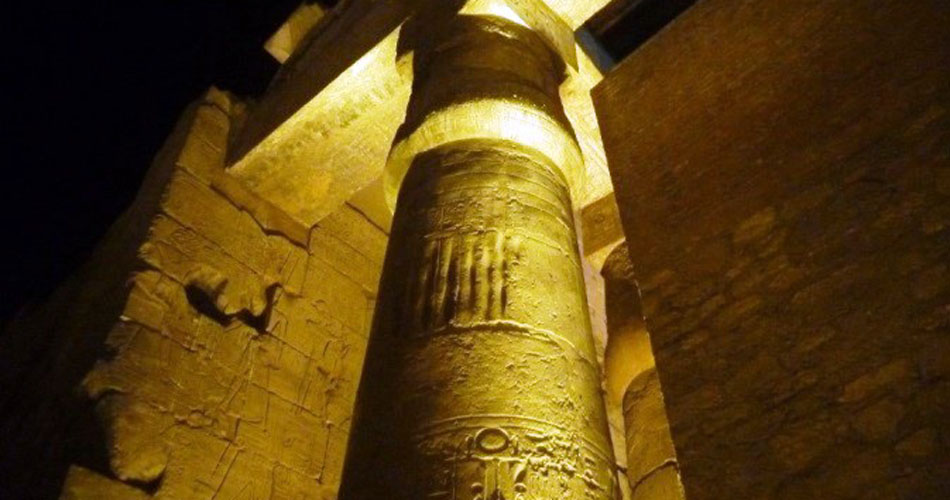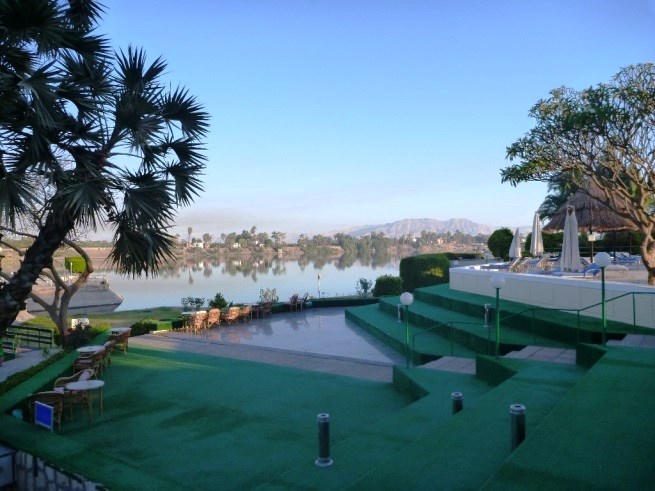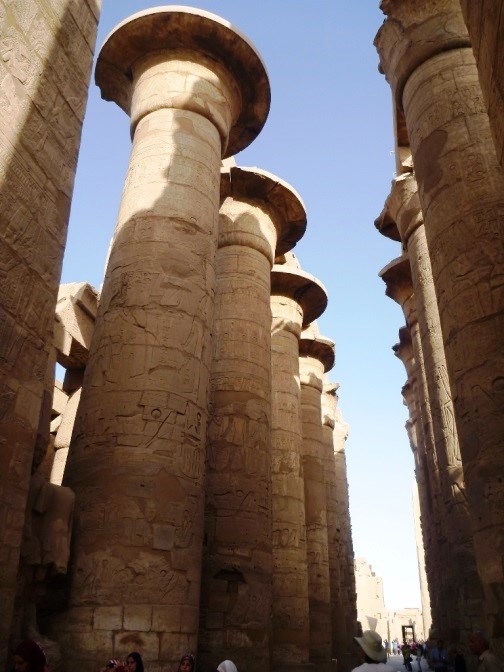Luxor Egypt 2015

Luxor, Karnak, and the Nile River
LUXOR!!!! WOW!!!… an amazing experience. This short but wonderful trip absolutely ranks among the top highlights of our cruising journey thus far. Standing amid the ancient ruins, temples and tombs, paintings and hieroglyphics, is dazzling and breathtaking.
We should have had a tourist police permit to travel to Luxor and we should have taken a different (though longer) route, but we didn’t. Abrahem, our new Egyptian friend from Luxor and the driver both tried getting the permit for us. They didn’t have our passport information and didn’t have enough time to complete the process. That cost us about a half hour at the first police checkpoint in El Quesir. After a few phone calls, some baksheesh paid and a lot of yelling, arm waving, and cigarette smoking, we got permission to continue on our way. As we neared Luxor, we took a detour through the back streets and behind the airport the long way to avoid the final police checkpoint. We eventually made it into town and to Abrahem’s home to meet his family and enjoy a nice meal.
Abrahem’s brother-in-law Mohamed, an Egyptologist and freelance tour guide, was to spend the next two days with us. He picked us up and we headed to the Luxor Temple. It was dusk and the lights were on at the temple. It was magical seeing the obelisk out front, the huge statues and columns, and the “Avenue of Sphinxes”, which leads north to Karnak Temple.

A mosque is built on top of a portion of the Luxor Temple, and we toured it as well. It was interesting to have this opportunity to peek inside a mosque. Mohamed told us so much about the history of the gods and the kings and queens. He told us about many of the words that had been changed from the ancient Egyptian language by the Greeks, leading to our current-day terminology, including the word Pharaoh for one of power or leader.
After Luxor Temple and the mosque, we checked into our hotel, the Jolly Vive on Kings Island, located on a small island in the Nile River. Breakfast was included and we enjoyed a vast array of delectable treats on the terrace overlooking the Nile… you simply cannot beat that! 🙂

The next morning, we started out early and spent the entire day at the tombs and temples of the necropolis on the west bank of the Nile. Our first stop was to the Valley of the Kings, where the pharaohs are buried. In ancient times there were also female pharaohs who ruled in Egypt. The carvings and the paintings in these tombs are both elaborate and exquisite. Because the tombs are located in such a dry climate and dug deeply into the mountainsides, the paint is intact to a large degree. The walls and ceilings are covered in pictures and hieroglyphics telling of the battles and life of the times. The pharaohs actually had their tombs constructed during their lifetimes. Each tomb consists of an entrance hall, several chambers and then the final chamber where the mummified body was placed in sarcophagi. The sarcophagus was an outer stone structure into which was placed several inner caskets. The tomb contained riches and tools for the deceased to travel through the underworlds (there were two of them – good and evil). The locations of the tombs were chosen to be placed under pyramid-shaped rock formations in Thebes (ancient Egyptian name for Luxor), so they didn’t have to build the pyramids themselves, like they did in Giza.
After the Valley of the Kings, we went to Al-Deir Al-Bahari Temple, the Mortuary Temple of Hatshepsut. It was designed and implemented by Senenmut, royal architect of Hatshepsut, believed to be her lover. Hatshepsut’s son came to power when he was young but Hatshepsut sent him off and she took the crown herself. When she eventually died and her son became king, he unfortunately had the images of Hatshepsut scratched out from the walls here in revenge. This temple is where they performed the process of mummification, a 70-day process before the final burial.
Our next stop was to R’Mose, or temple of Ramose, in Sheikh abd Al-Querna, or the Valley of the Nobles. The carving here is incredible. So delicate with perfectly carved ears and thumbs, intricately carved jewelry and wigs, styled differently for each individual. There were the most beautifully carved hieroglyphics… perfect little owls, horses and faces. Just beautiful!
Following the Valley of the Nobles, we visited Deir al-Madina, which is the place the workers had lived and where they were buried. The tombs in the Valley of the Kings, Queens and Nobles were all built and decorated by workers who were paid… not by slaves. Although the two tombs we visited were not nearly as large or as elaborately decorated as those of nobility, they were lovely and impressive none-the-less.

We continued on to the Valley of the Queens and visited the tombs of one of the wives of King Ramses II, Queen Titi and prince Amonherkhepshef. Princes under the age of 13 were buried in the Valley of the Queens. Our last stop on the west bank was to Habu Temple. This temple was built by Ramses III at the time where the Egyptian empire was already in decline. King Ramses III was able-bodied and proficient in hunting. Many of the carvings at this temple depicted him on his chariot hunting.
The next morning, we started off in a horse carriage to visit the local markets. We weren’t sure we wanted to do this, both because it seemed very touristy and because of Sher’s allergy to horses, but Mohamed assured us that this was the best way to travel into the markets. Unfortunately, we were right on both accounts… touristy and a seriously runny nose. We walked around, then decided on a car for further transportation to the live animal market (we resisted the temptation to buy a goat) and then the Luxor Museum, which was splendid. We spent hours gazing at statues and learning more about early Egyptian history. There were also two mummies in residence at the museum, one of which was thought to be King Ramses I.
Our final destination was Karnak Temple. We spent hours there and we were dazzled by the enormity and detail of the columns, obelisks, and the carved and painted walls of the temples housed within the complex. We learned why all offerings to the temple were allowed except humans (somewhat obvious) and fish, a complex story of love, hate, infidelity, deception, revenge and forgiveness. Hmmm, we thought it was because of the fishy smell.

We headed back to Port Ghalib the following morning and enjoyed a shorter and less controversial ride, with official papers, but still somewhat hidden in the back of the van (with curtains drawn) to prevent any potential issues at checkpoints.


